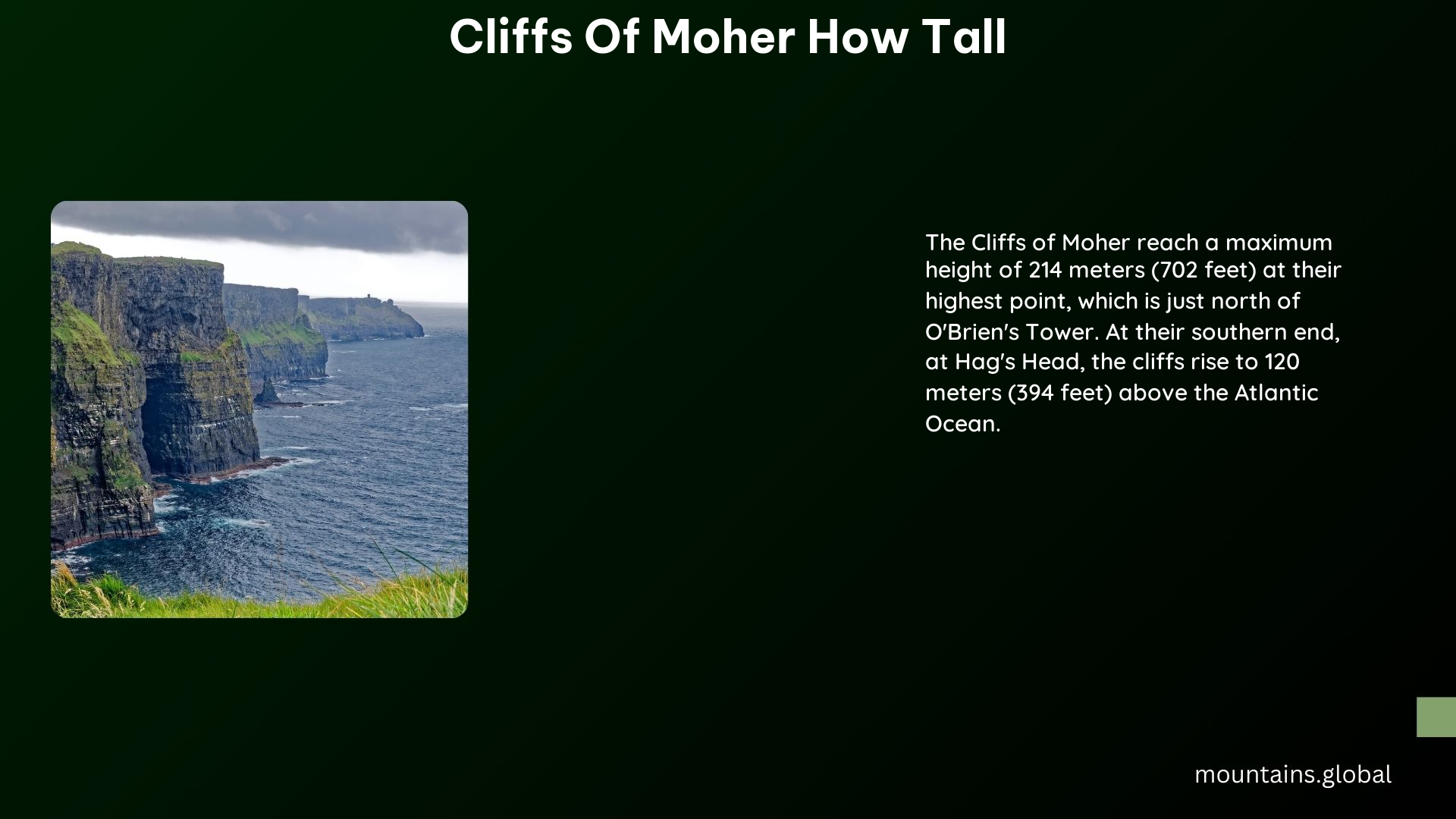The Cliffs of Moher, located in County Clare, Ireland, are renowned for their breathtaking height and dramatic vertical drop. These iconic sea cliffs reach a maximum height of 214 meters (702 feet) at their tallest point near O’Brien’s Tower. Stretching for 14 kilometers along Ireland’s western coastline, the Cliffs of Moher offer visitors awe-inspiring views of the Atlantic Ocean and have become one of the country’s most popular natural attractions.
What Is the Maximum Height of the Cliffs of Moher?

The Cliffs of Moher reach their pinnacle height of 214 meters (702 feet) just north of O’Brien’s Tower. This impressive elevation is equivalent to the height of a 70-story skyscraper, offering visitors a truly breathtaking experience. The sheer vertical drop from this point to the crashing waves of the Atlantic Ocean below creates a dramatic and awe-inspiring sight that has captivated millions of visitors from around the world.
To put this height into perspective, consider the following comparisons:
- Empire State Building (without antenna): 381 meters (1,250 feet)
- Eiffel Tower: 324 meters (1,063 feet)
- Cliffs of Moher: 214 meters (702 feet)
- Statue of Liberty (from base to torch): 93 meters (305 feet)
As you can see, while not as tall as some of the world’s most famous structures, the Cliffs of Moher still stand as an impressive natural wonder, especially considering their formation through millions of years of geological processes.
How Does the Height Vary Along the Cliffs?

The height of the Cliffs of Moher is not uniform throughout their 14-kilometer stretch. Here’s a breakdown of the varying heights along the cliffs:
- Northern section (near O’Brien’s Tower): 214 meters (702 feet)
- Central section: Varies between 170-200 meters (558-656 feet)
- Southern end (Hag’s Head): 120 meters (390 feet)
This variation in height adds to the visual interest of the cliffs, creating a dynamic and ever-changing landscape as visitors walk along the cliff-top paths.
What Is the Significance of O’Brien’s Tower?
O’Brien’s Tower, built in 1835 by Sir Cornelius O’Brien, serves as both a viewing point and a landmark at the Cliffs of Moher. Its location near the highest point of the cliffs is no coincidence. Here are some key facts about O’Brien’s Tower:
- Height: 19 meters (62 feet)
- Purpose: Originally built as an observation tower for Victorian tourists
- Views: Offers panoramic views of the Aran Islands, Galway Bay, and the Twelve Pins mountain range in Connemara
- Access: Visitors can climb to the top for an additional fee
The tower’s position at the cliffs’ highest point makes it an ideal spot for photographers and nature enthusiasts to capture the full majesty of the Cliffs of Moher.
How Do the Cliffs of Moher Compare to Other Famous Cliffs?
While the Cliffs of Moher are undoubtedly impressive, it’s interesting to compare them to other famous cliffs around the world:
| Cliff Name | Location | Maximum Height |
|---|---|---|
| Cliffs of Moher | Ireland | 214 meters (702 feet) |
| Slieve League | Ireland | 601 meters (1,972 feet) |
| Preikestolen (Pulpit Rock) | Norway | 604 meters (1,982 feet) |
| Kalaupapa Cliffs | Hawaii, USA | 1,010 meters (3,315 feet) |
| Trango Towers | Pakistan | 1,340 meters (4,396 feet) |
As you can see, while the Cliffs of Moher may not be the tallest in the world, their accessibility, dramatic beauty, and cultural significance make them a standout attraction.
What Geological Factors Contributed to the Cliffs’ Height?
The impressive height of the Cliffs of Moher is the result of millions of years of geological processes. Understanding these factors helps appreciate the cliffs’ formation:
- Rock composition: The cliffs are primarily composed of Namurian shale and sandstone, formed over 300 million years ago.
- Glacial activity: During the last Ice Age, glaciers helped shape the landscape, carving out softer rock and leaving behind the more resistant layers.
- Erosion: Continuous erosion by wind and waves has further sculpted the cliffs, creating their distinctive vertical faces.
- Tectonic activity: The movement of tectonic plates over millions of years has contributed to the uplift of the rock formations.
These combined factors have resulted in the towering cliffs we see today, with their characteristic layered appearance and imposing height.
How Has the Height of the Cliffs Impacted Local Wildlife?
The significant height of the Cliffs of Moher has created a unique ecosystem that supports a diverse range of wildlife, particularly seabirds. Some notable impacts include:
- Nesting sites: The vertical faces provide safe nesting spots for various seabird species, protected from land-based predators.
- Updrafts: The cliffs’ height creates strong updrafts, which seabirds use for effortless soaring and hunting.
- Microclimate: The cliffs’ elevation affects local weather patterns, creating microclimates that support unique plant life.
Some of the bird species that benefit from the cliffs’ height include:
- Atlantic Puffins
- Razorbills
- Common Guillemots
- Kittiwakes
- Fulmars
- Peregrine Falcons
The height of the cliffs not only provides a spectacular view for human visitors but also plays a crucial role in supporting this rich biodiversity.
What Safety Measures Are in Place Due to the Cliffs’ Height?
Given the impressive height of the Cliffs of Moher, safety is a paramount concern for visitors. The following measures have been implemented to ensure visitor safety:
- Protective barriers: Sturdy fencing and walls are in place along the cliff edge in popular viewing areas.
- Warning signs: Clear signage alerts visitors to potential dangers and advises staying on designated paths.
- Visitor center: The center provides information on safe viewing practices and current weather conditions.
- Guided tours: Official guides offer tours that emphasize safety while providing interesting information about the cliffs.
- Restricted areas: Some sections of the cliffs are off-limits to visitors due to instability or particularly dangerous conditions.
Despite these measures, visitors are always advised to exercise caution, stay on marked paths, and avoid approaching the cliff edge, especially in windy conditions.
How Has the Height of the Cliffs Influenced Tourism?
The impressive height of the Cliffs of Moher has been a significant factor in their popularity as a tourist destination. Here are some ways the cliffs’ height has impacted tourism:
- Scenic views: The sheer drop offers unparalleled views of the Atlantic Ocean and surrounding landscape.
- Photography opportunities: The dramatic height provides excellent subjects for both amateur and professional photographers.
- Adventure tourism: The cliffs’ height has attracted adventure seekers, leading to the development of activities like cliff-top walks and boat tours.
- Cultural significance: The imposing nature of the cliffs has inspired legends and folklore, adding to their cultural appeal.
Tourism statistics reflect the cliffs’ popularity:
- Annual visitors: Over 1.5 million (pre-pandemic)
- Economic impact: Significant contributor to the local and national economy
- International recognition: Featured in numerous films and TV shows, further boosting their global appeal
The height of the Cliffs of Moher, combined with their accessibility and natural beauty, has cemented their position as one of Ireland’s top tourist attractions.
In conclusion, the Cliffs of Moher’s impressive height of 214 meters (702 feet) at their tallest point is a key factor in their enduring appeal. From providing a haven for wildlife to attracting millions of visitors annually, the cliffs’ towering presence continues to inspire awe and wonder, making them a true natural treasure of Ireland.
References:
1. Cliffs of Moher | New7Wonders of Nature
2. Cliffs of Moher Travel Guide – Wilderness Ireland
3. Cliffs of Moher – Wikipedia
